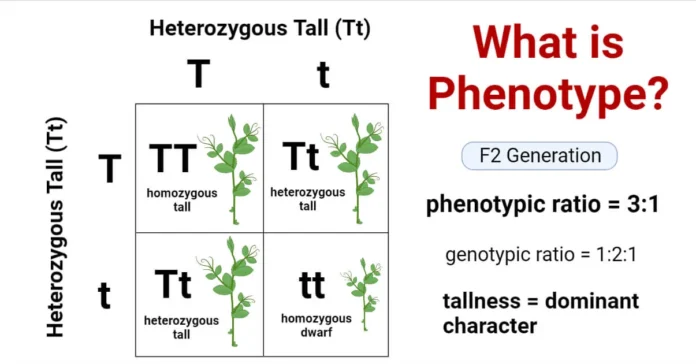Introduction
Phenotype is a term used in biology to describe the observable physical, behavioural, and physiological traits of an organism that are determined by its genetic makeup and the environment in which it lives. It is a key concept in genetics, evolution, and medical research, providing insights into how traits are inherited, how species adapt to changing environments, and how diseases are caused and treated.
Phenotype Definition
The term phenotype is derived from the Greek word “phainein” which means to show or to appear. It refers to the physical, biochemical, and behavioural traits that are expressed by an organism. These traits can be influenced by both genetic and environmental factors and can range from visible traits such as eye colour, height, and hair colour to more complex traits such as disease susceptibility, behaviour, and intelligence.
Types of Phenotype
There are three main types of phenotype: physical, behavioural, and physiological.
- Physical Phenotype:This type of phenotype refers to observable physical traits, such as the size, shape, colour, and texture of an organism. These traits can be influenced by both genetics and the environment and can vary widely among individuals of the same species.
- Behavioral Phenotype: This type of phenotype refers to observable behavioural traits, such as patterns of movement, communication, or social behaviour. These traits are often shaped by the environment in which an organism lives, as well as by its genetics.
- Physiological Phenotype: This type of phenotype refers to observable physiological traits, such as metabolic rate, blood pressure, or immune response. These traits are large determined by genetics, but can also be influenced by environmental factors such as diet, exercise, or exposure to toxins.
Applications of Phenotypes
- Understanding Genetic Variations: Phenotype plays a crucial role in understanding genetic variations among organisms. By analyzing the physical and observable characteristics of organisms, scientists can identify the genes responsible for specific traits and study their inheritance patterns.
- Evolutionary Studies: Phenotype is an important aspect of evolutionary studies. The observation of phenotypic changes in a population over time helps scientists understand the forces that drive evolution, such as natural selection and genetic drift.
- Medical Diagnostics: In medicine, the phenotype is used to diagnose genetic disorders and identify genetic risk factors for diseases. Physicians can use observable traits to determine if an individual carries certain genetic mutations or has a higher risk of developing a certain disease.
- Agriculture and Animal Breeding: Phenotype is also important in agriculture and animal breeding. Farmers and breeders use observable traits to select the best crops and animals for breeding, with the goal of producing offspring with desirable traits.
Examples of phenotypes
Here are some examples of phenotypes:
- Eye colour in humans: Eye colour is a classic example of a phenotype. It is determined by several genes, including OCA2, HERC2, and TYR, and is influenced by environmental factors such as light exposure. Eye colours can range from blue to brown and can even change over time.
- Flower colour in plants: Flower colour is an important phenotype in plants as it attracts pollinators. It is determined by the presence or absence of pigments such as anthocyanins and carotenoids. For example, in snapdragons, the presence of anthocyanins produces red or pink flowers, while their absence produces white flowers.
- Fur colour in animals:Fur colour is another classic example of a phenotype. It is determined by genes that regulate the production and distribution of pigments such as melanin. For example, in mice, the Agouti gene produces a coat colour that is a mix of yellow and black, while the Albino gene produces a white coat.
- Behaviour in animals: Phenotypes can also influence behaviour in animals. For example, aggression in dogs is partly determined by genes that regulate the production and distribution of hormones such as testosterone. Environmental factors such as socialization and training also play a role in shaping behaviour.
Factors Influencing Phenotype
Phenotype is the observable physical and biochemical characteristics of an organism, which are influenced by various factors, including genetic, environmental, and developmental factors. Here are some factors that influence phenotype:
- Genetics: The genetic makeup of an organism plays a significant role in determining its phenotype. Genes code for specific proteins and enzymes that control various traits such as eye colour, height, and hair type.
- Environment: The environment in which an organism develops and lives can also influence its phenotype. For example, exposure to different temperatures, light levels, or nutrients can affect the growth and development of an organism.
- Developmental Processes: The way an organism develops can also affect its phenotype. Developmental processes such as cell differentiation and cell migration play a crucial role in determining the final phenotype of an organism.
- Nutrition: Nutrition plays a critical role in the development and expression of the phenotype. The type and amount of nutrients an organism consumes can affect its growth, development, and overall health.
FAQs
Q1. What is the difference between genotype and phenotype?
Ans. Genotype refers to the genetic makeup of an organism, while phenotype refers to its observable traits. Genotype determines the potential traits that an organism can express, but the actual expression of these traits is influenced by environmental factors.
Q2. Can phenotypes change over time?
Ans. Yes, phenotypes can change over time due to a variety of factors, including ageing, disease, and changes in the environment.
Q3. How can studying phenotypes help in the field of medicine?
Ans. Studying phenotypes can help us understand how different individuals may respond differently to certain treatments or be at higher risk for certain diseases. This knowledge can inform the development of personalized medicine.
Q4. Are all traits considered part of phenotype?
Ans. No, only observable traits are considered part of the phenotype. These traits that are not observable, such as blood type, are part of an organism’s genotype.
Q5. How do scientists study and measure phenotype?
Ans. Scientists study and measure phenotypes through a variety of methods, including observational studies, surveys, and laboratory experiments.
